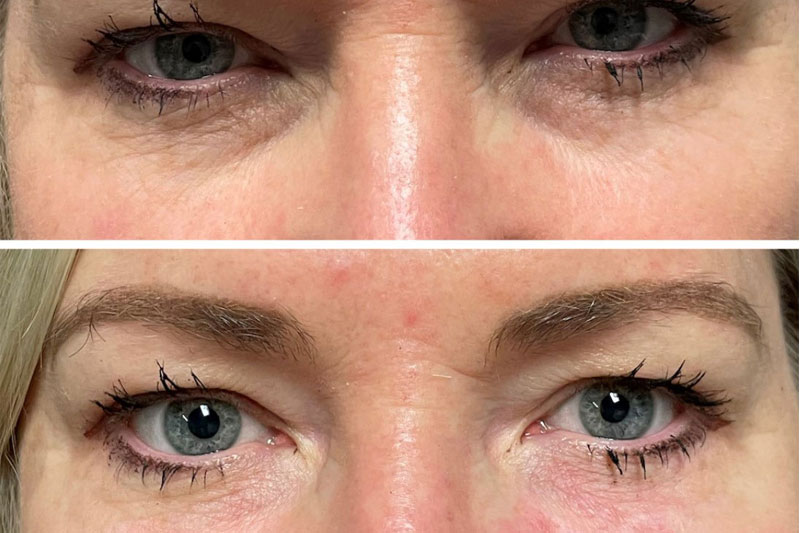Featured Service: PRP Under Eye Treatments
Platelet-rich PRP plasma therapy, sometimes called PRP therapy or autologous conditioned plasma (ACP) therapy, relieves pain by promoting long lasting healing of musculoskeletal conditions using the healing power of your own body. PRP is injected into the affected joint. The goal is to reduce pain, improve joint function, possibly slow, halt or even repair damage to the cartilage.
Plasma refers to the liquid component of the blood; it is the medium for red and white blood cells and other material traveling in the bloodstream. Plasma is mostly water but also includes, nutrients, glucose, and antibodies, among other components.
PRP Knee Injections
Are you or someone you know suffering from knee pain? Knee pain can be a debilitating condition that affects your daily life. PRP treatment (Platelet-Rich Plasma (PRP) injections) involves drawing a small amount of your own blood and then separating the platelets from the other blood components. These platelets are then injected into the affected area, in this case, the knee. The platelets contain growth factors that help to promote healing and reduce inflammation.
Studies have shown that PRP injections can be effective in reducing knee pain and improving knee function. One study published in the Journal of Arthroscopic and Related Surgery found that patients who received PRP injections had significant improvements in pain and function compared to those who received a placebo injection.
PRP therapy has been shown to be effective in treating a variety of knee injuries, including osteoarthritis, meniscus tears, and ligament sprains. It works by stimulating the natural healing process in your body, which can lead to reduced pain, improved function, and a faster recovery time.

PRP Microneedling
PRP Microneedling is a non-invasive cosmetic procedure that involves the use of a device called a microneedling pen. The pen uses tiny needles to create micro-injuries on the skin. These injuries stimulate the body’s natural healing process, which includes the production of collagen and elastin. PRP is then applied to the skin to enhance the healing process and promote skin rejuvenation. The procedure is typically done in-office and takes about 30 minutes to complete.
Frequently Asked Questions about PRP Injections Treatment
PRP is an acronym for Platelet-Rich Plasma. PRP is used in facial rejuvenation treatments to help improve overall skin texture. PRP also decreases the appearance of fine lines and wrinkles.
PRP contains growth factors that stimulate collagen production. Under-eye PRP treatments are excellent for addressing fine lines, wrinkles, dark circles, and puffiness. Improvement in treated areas is visible within minutes of application. These treatments provide patients with a natural option for under-eye issues.
The first step is collecting the blood. One tube of blood is drawn from the patient and then spun in a centrifuge where the blood is separated into layers. The plasma is then extracted and re-injected back into the under-eye area being treated.
An initial assessment will determine the health of the skin and everyone’s goals to determine if the treatment is appropriate for the problem. It is important that the patient understands that PRP injections are a natural way of treatment and are not designed to give the same results as surgical procedures such as blepharoplasty.
PRP injections treatments last longer than fillers but results are not permanent. For many patients, the lasting results are from 1-2 years, depending on the patient’s current age and skin condition. Patients are encouraged to do 3 initial treatments 4 weeks apart, then maintenance 8-12 months as needed.
No downtime is needed, and minimal side effects or complications occur. Some patients verbalize experiencing tingling sensations as the plasma starts to work but does not cause much discomfort for most. Normal activities can be resumed the following day, along with aftercare instructions for PRP treatments.
- Avoid touching the injection site for the next 24hrs.
- Avoid taking Aspirin, Ibuprofen, Advil, Naproxen or Aleve following the procedure. Tylenol is recommended.
- Avoid alcohol, exfoliation, and massaging the area for 72hrs.
- Sleeping with the head of the bed elevated is recommended to reduce swelling.
While PRP injections are considered safe for most people, the treatment is NOT recommended for anyone who has one of the following medical conditions:
- Hepatitis C
- HIV or AIDS
- Any type of blood cancer or blood disorder
- Cardiovascular disease, which requires taking a blood thinner
- Skin cancer in the area to be treated, active rosacea
- Lupus
- Autoimmune disorders
These conditions affect your platelets, making them unable to deliver the expected results.





